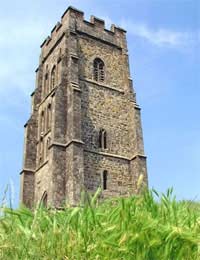The Myths and Legends at Glastonbury

There are many Myths and Legends at Glastonbury, two of which deal with Bible stories - one directly and one indirectly. Glastonbury’s tales are often told singularly, as if each telling were the one and only myth of the land, but when taken together they form many connections, like the varied twigs and branches of one great, ancient tree.
King Arthur
The Arthurian legends stretch out across many lands, but in Glastonbury there seems to be a nexus of sorts. Indeed many believe that this is where fabled Camelot once existed, the backdrop of the famous Knights of the Round Table, Merlin the wizard and the tragic and heroic figure of Arthur himself.In nearby South Cadbury there is a hill fort, a possible ancient remnant of Camelot proper. There is proof that the hill fort dates back to the early 6th century -- and this is when many believe the time of Camelot was.
There are more physical hints to possible legendary connections between Glastonbury and famed Camelot. The enchanting hill that rises above the lands of Glastonbury -- known as the Glastonbury Tor -- is believed by some to be the mythical Isle of Avalon. At first blush it seems like a silly link; after all, shouldn’t an Isle be surrounded by water? But upon further examination it isn’t as silly as it sounds.
In the 6th century the water levels of the region were much higher, which could very well have turned the Tor into an Isle; an Isle often referred to the “Island of Glass” - a possible etymological connection to the word “Glastonbury?”
Indeed the very structures of the land are often linked to Arthurian legend. One such myth suggests that the varying architecture was laid out in conjunction with the landscape to provide a sort of celestial zodiac calendar with Arthurian imagery. Also at the Glastonbury Abby monks claimed in the 12th century to have found a stone marked “Here likes Arthur, king” and under it a man and woman’s skeletons - the bones of Arthur and his wife, Queen Guinevere?
The Grail
The Holy Grail features prominently in Arthurian legend, which links to another set of myths around a biblical figure - Joseph of Arimathea. Believed to be Jesus’ uncle, this Joseph was supposedly the bearer of the grail from the Holy Land - along with, according to legend - the body of the Messiah.The grail was supposed to contain a few drops of Jesus’ blood, and legend has it that Joseph buried it at the foot of the Glastonbury Tor, from which sprang a spring of blood. To this day there is the Chalice Well, where the water often has a reddish cast.
Also it was said that when Joseph of Arimathea arrived in Glastonbury he stuck his thorn staff into the ground and it turned into a thorn tree and blossomed. A cutting was taken from that tree and planted in the Glastonbury Abby, where to this day a thorn tree from Palestine blossoms every Christmas.


Re: A Black Cat Crossing Your Path
For about 6 months i kept seeing cats crossing the road whilst i was working in care in the cimmunity the cats were mostly black…
Re: Do Birds Flying Into A Home Equate To Death?
So about a year ago I had two baby bird get in my room through the ceiling. I was in a shelter and the birds…
Re: Where Does the Name Nylon Originate?
I remember seeing a BBC documentary about Wallace Carothers, in which the New York-London idea was debunked. It seems…
Re: Do Birds Flying Into A Home Equate To Death?
Ive had a woidpecker. Pecking at my bedroom window. A few times in last couple wks. Then while i was camping…
Re: Spilling Salt
But if i throw some salt over my left shoulder and i get some under my nails, and then the salt falls out is it still considered bad luck? I ask…
Re: Women on Board Ship - Bad Luck
I'm 99% sure that the figurehead in the image at the top of this page is mine. It was attached to our 1930 wooden schooner but…
Re: A Black Cat Crossing Your Path
I saw two maybe three black cats on my porch one stood in front of my door way as I was knocking to get in I had no key so I…
Re: A Black Cat Crossing Your Path
A black cat came on my patio looked in my screen door at me and I made eye contact with it then it walked away. What does that…
Re: Spilling Salt
However I would like you to contact me and I need more explanation I need to understand more things and if it’s your desire to help Someone please…
Re: A Black Cat Crossing Your Path
Came on my front porch to a black cat lying in a broken chair not afraid of me or my kids at all ....is this bad